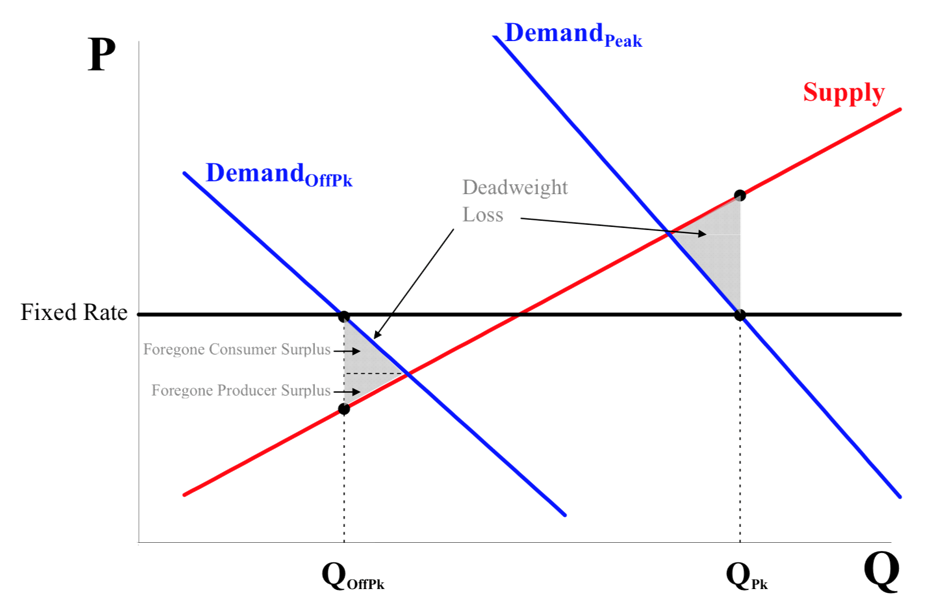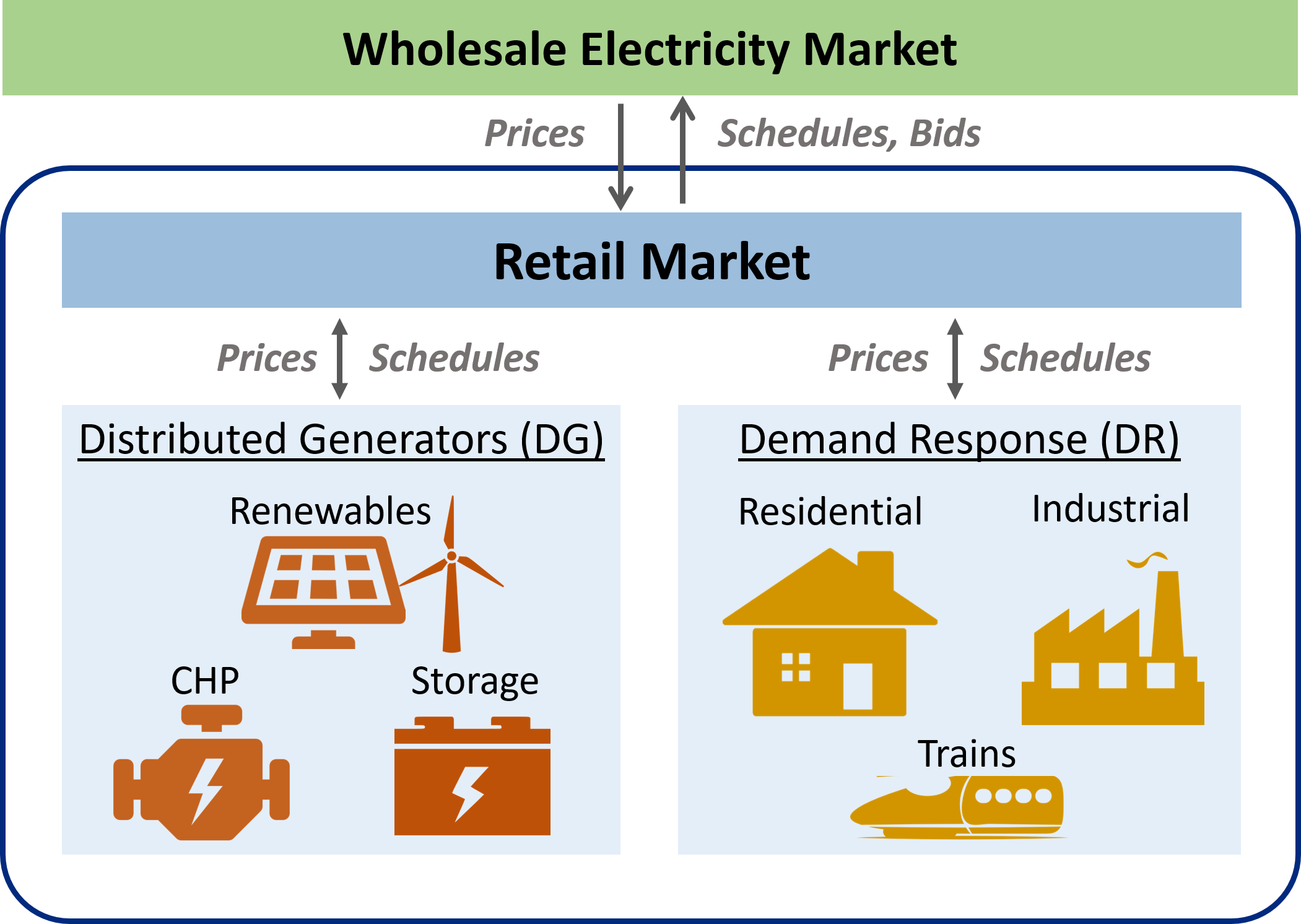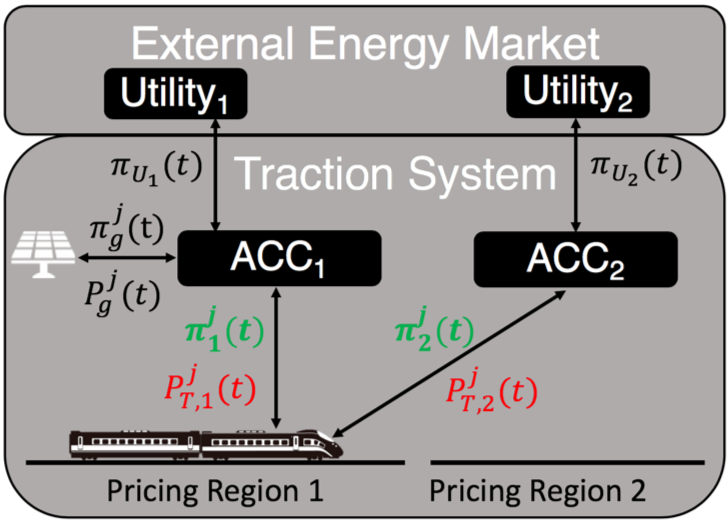Smart Grid
The electric power grid is undergoing a transformation as we seek to reduce our environmental footprint and reliance on foreign fuels while simultaneously electrifying transportation and heating. These concerns have led to a focused effort towards a high penetration of distributed energy resources (DERs), which include distributed generation (DG), demand response (DR), and storage. These small-scale resources can provide various services to the grid including voltage support from clusters of DERs, reduced line congestion from better generation/load management, lower operating costs by using cheaper resources (ex. renewables), and demand flexibility by enabling DR throughout the distribution grid. Technologies such as storage and price-responsive demand systems are also being adopted at an accelerating pace, in an attempt to reduce operational costs and manage increasingly dynamic electrical system conditions. Sensing and control systems need to be revisited to efficiently integrate these new technologies, transforming our energy systems into smart grids. The following are specific topics that are currently under investigation:
Distributed Optimization Algorithm for Smart Distribution Grids
 The modern grid is characterized by the high penetration of Distributed Energy Resources (DERs), including generation units, flexible consumption units (demand response), and storage, which are largely owned by different third-party agents. To take advantage of these distributed resources and maintain privacy for individual agents, a fully distributed control architecture is necessary. This corresponds to having a fully distributed optimization algorithm, which will solve the Optimal Power Flow (OPF) problem: determining actuation of DERs constrained by power flow physics, grid limits, and meeting electricity demand.
The modern grid is characterized by the high penetration of Distributed Energy Resources (DERs), including generation units, flexible consumption units (demand response), and storage, which are largely owned by different third-party agents. To take advantage of these distributed resources and maintain privacy for individual agents, a fully distributed control architecture is necessary. This corresponds to having a fully distributed optimization algorithm, which will solve the Optimal Power Flow (OPF) problem: determining actuation of DERs constrained by power flow physics, grid limits, and meeting electricity demand.

This project has culminated in the fully distributed Proximal Atomic Coordination (PAC) algorithm, which exhibits similar convergence rates to the popular Alternating Direction Method of Multipliers (ADMM) algorithm (O(1/tau), tau = number of iterations), but has lower communication requirements, shorter iteration time, and most crucially, data privacy between agents is an intrinsic property of PAC.
An optimization problem over a connected network is decomposed into K different coupled sub-optimization problems. Dependencies between atoms are dealt with by creating local “copies” of variables owned by other atoms, and introducing additional constraints to force these local copies to converge to the real values of the variables. In contrast, ADMM treats dependencies as shared variables between atoms. The dynamics of the PAC algorithm involve the system moving towards feasibility (meeting OPF constraints) and moving towards consistency (local copies = real variables), while trying to minimize a Lagrangian objective function for each agent.

Future works:
- Analyze robustness of PAC to cyber-events (failure or attack in communication network)
- Develop asynchronous PAC variant
Retail Market Mechanisms for Distribution Grids

In the United States, the procurement and integration of distributed generators (DGs) is largely limited to providing ancillary services through participation in the Wholesale Electricity Market (WEM); there is some participation from DR units and storage devices evidenced by FERC order 841. Typically, these DERs must meet minimum size requirements, with some electricity markets not allowing aggregation. As the penetration of DERs increases, specifically renewable generation, demand response, and storage, the WEM alone may not suffice in realizing an efficient and reliable power delivery. A properly designed retail market that oversees the participation of variable scale DERs in the distribution grid and implements a suitable mechanism for their scheduling and compensation is highly necessary.

To address these issues, we have been developing a retail market mechanism which details a real-time pricing scheme for distribution grids in the presence of high DER penetration, enabled by the recently developed distributed optimization algorithm, the proximal atomic coordination algorithm (PAC). We introduce a Distribution System Operator (DSO), which handles market settlements with the WEM on behalf of the distribution grid, charges agents for their consumption, and compensates flexible consumers and generators. By using the retail market, the distribution grid is more efficiently managed, and smaller DERs are able to participate in the WEM by bidding through the DSO. A case study conducted on a distribution grid in Komae City, Tokyo, Japan, shows the retail market mechanism results in projected savings over a 24-hour period for the DSO.
 Future works:
Future works:
- Relaxing assumption that the load/generation profile of DSO is not binding at each WEM clearing
- Designing a bidding mechanism between the DSO and WEM
- Multi-period market settlements
- Incorporating storage units and appropriate compensation
- Better modeling of DR contracts
Transactive Control of Electric Railway Systems

Electric railway systems are a major untapped source of demand-side flexibility in electricity networks. Electric trains can both demand power from their traction system for locomotion and inject power back into the electricity network through regenerative braking, virtually enabling them to store electricity in the form of kinetic energy. The power profile of a train along a route is in many cases determined by the conductor based on training and experience, attempting to meet a given schedule with little regard to the varying cost of power along the route.
We propose an alternative operation methodology that solves the energy cost minimization problem, taking into account the scheduling and operational constraints of the railway system. In addition, we provide a control mechanism to coordinate multiple trains and rail-side distributed energy resources (DERs) tied to the electric railway, which dynamically change the price of electricity along the track, ultimately enabling the operational cost minimization of the system. The proposed transactive control methodology has been tested in numerical simulations of the high-speed Amtrak Acela service which operates along the northeast United States suggesting savings on the order of 10% of the annual energy costs of the operator.
Hierarchical local electricity markets

Our novel LEM architecture can be used to optimally schedule and coordinate DER injections across the distribution grid, via price-based market mechanisms instead of direct control or dispatch of DERs by the grid operator. We also show how the LEM can provide distribution grid services, specifically Volt-VAR control (VVC) for voltage regulation and conservation voltage reduction. We extend our market beyond radial, balanced systems to unbalanced, multi-phase and meshed networks by using a Current-Injection based linear model for solving AC Optimal Power Flow at the primary level, employing McCormick envelopes convex relaxations. A distributed Proximal Atomic Coordination algorithm is used for PM clearing which preserves privacy, reduces communication requirements, and improves computational tractability. We also introduce 3-phase pricing at both the SM and PM, to motivate how we can determine the value of such grid services in real-time energy markets based on an optimization framework. We disaggregate the distribution locational marginal prices (d-LMP) and local retail tariffs among different SMOs and DCAs, respectively, and decompose their components arising from economic objectives like maximizing social welfare and minimizing costs versus grid objectives like minimizing line losses and voltage profile deviations.